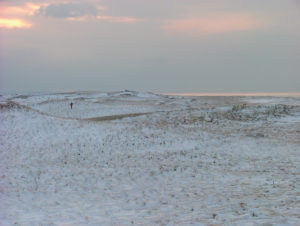Watching a shorebird is like watching a comet: you have to trick your eye into detecting it. To find a comet, you look sideways at the sky until your peripheral vision — more powerful at night than your regular vision — picks out a blotch of white from the neater points of light around it. To find a sanderling in winter, you look sideways down the beach, pretending to be absorbed in some other view, until a tiny bundle of gray and blue feathers twitches to life against its backdrop of identical colors. The bird will have disappeared by the time you’ve turned to fasten your full gaze on him — patches of wet pebbles, the sheen spread on the sand by a retreating wave, help to disguise him. But if you stand still and wait patiently, the sanderling will eventually stop looking sideways at you, and when he pivots to face you, his pearly white breast flashes, “Here I am.”
A lone sanderling had almost all of Race Point Beach to himself the other day. He was forced to share it with me and with another hiker, whose narrow silhouette roamed the dunescape that rolls westward from the ranger station. It was near sunset. When I first saw the hiker he was loping over the snow-flattened dune grass, carrying a long piece of driftwood in one hand like a staff, with his back to the spectacle playing out in the western sky — an eruption of gold light from the top of a bank of smooth blue clouds. The blue clouds hung low, setting off the color of the snow, and against its expansive whiteness the hiker’s stark outline seemed to contract even as he walked toward me. I was standing at the top of the hill next to the ranger station, and I moved down to the beach as he approached, not wanting to wreck his fantasy about having the place to himself — or not wanting to wreck mine.
The next thing I wrecked was the sanderling’s peace of mind. I had gone down to the edge of the water to look at a ship’s light blinking on the horizon when something flickered in the corner of my eye. The sanderling was foraging at the edge of the waves. He skittered further down when I turned to see if I could get a picture of him, and the next time I managed to locate him he was pacing back and forth in front of a washed-up log. I kept my distance, pretending to watch the ocean while secretly surveilling him. From where I stood he looked not much bigger than the blinking light on that boat 25 miles out.
That was all I saw: one bird, one man, one boat. And not even a whole boat. And not even a whole sunset. By the time I started walking back up the hill to the parking lot, the glow in the western sky had given way to dusk without really blossoming into the kind of rosy lightshow we look forward to in winter. The only color in the landscape came from two yellow squares burning where the ranger station windows looked out at the view — or pretended to.

